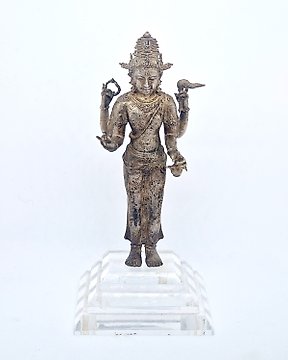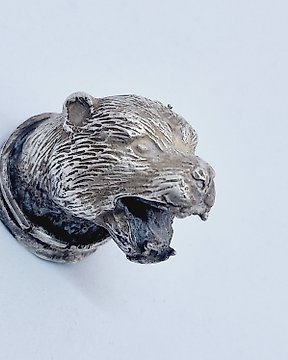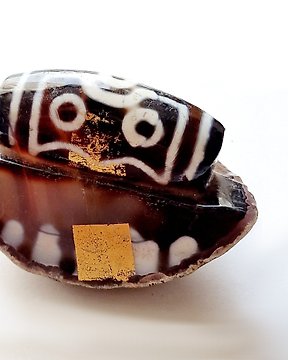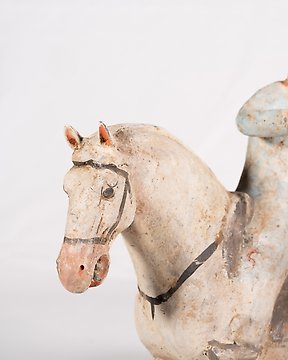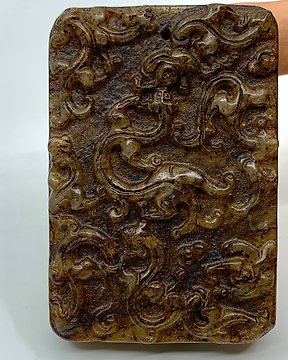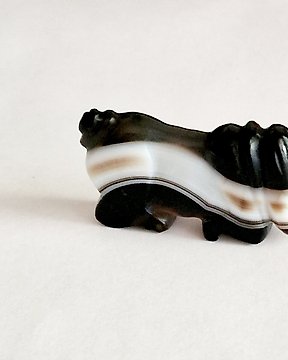Thank you for this nice bead!
Se översättningSogdian, sidenvägskultur Silver Ritual Cup med Ibex Palm Tree & Flowers - 140 mm
Nr 85021261
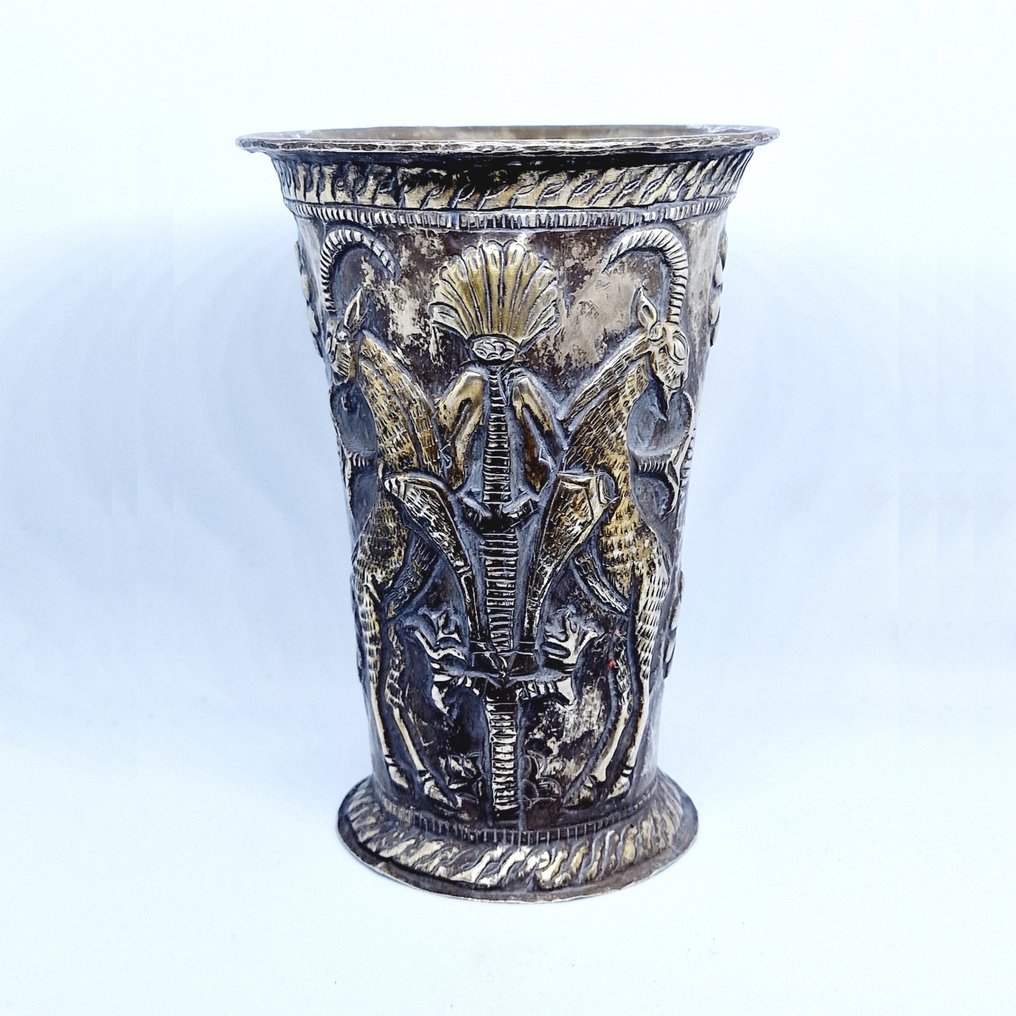
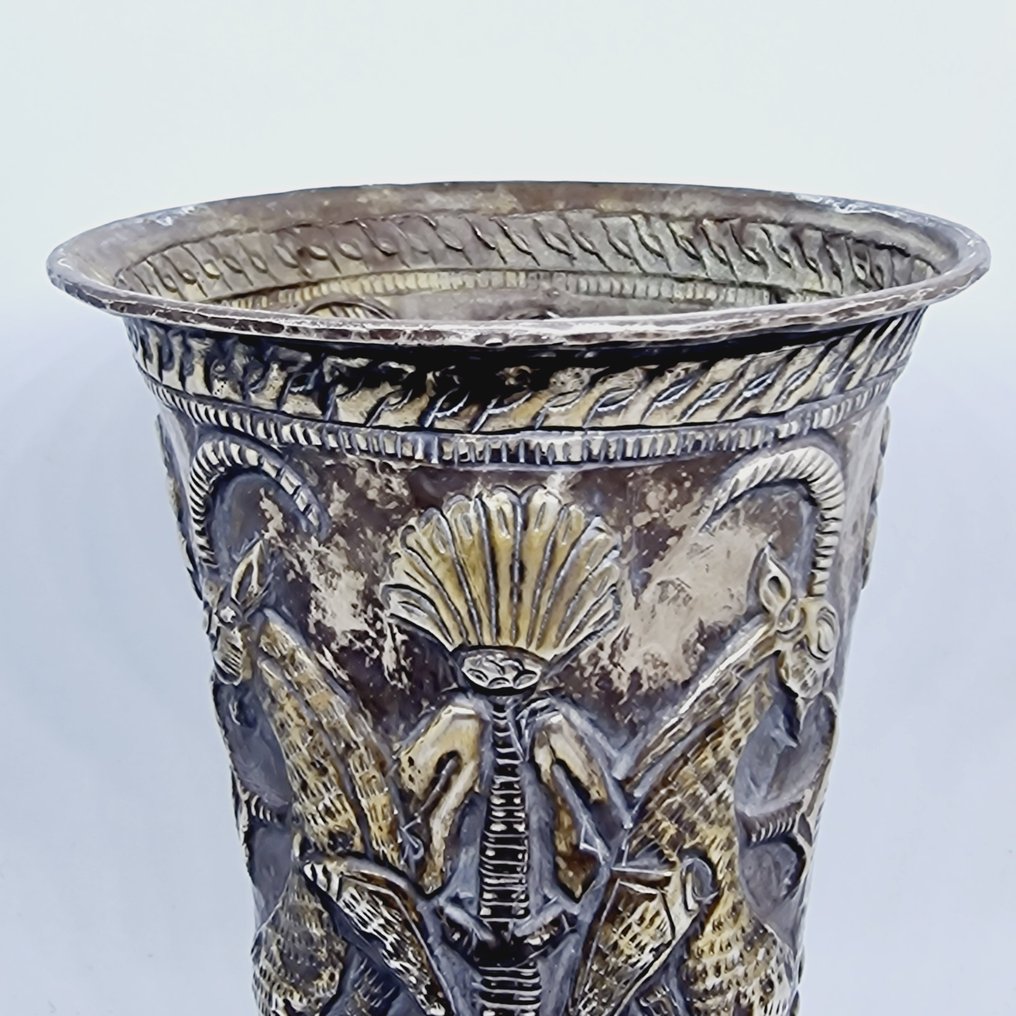
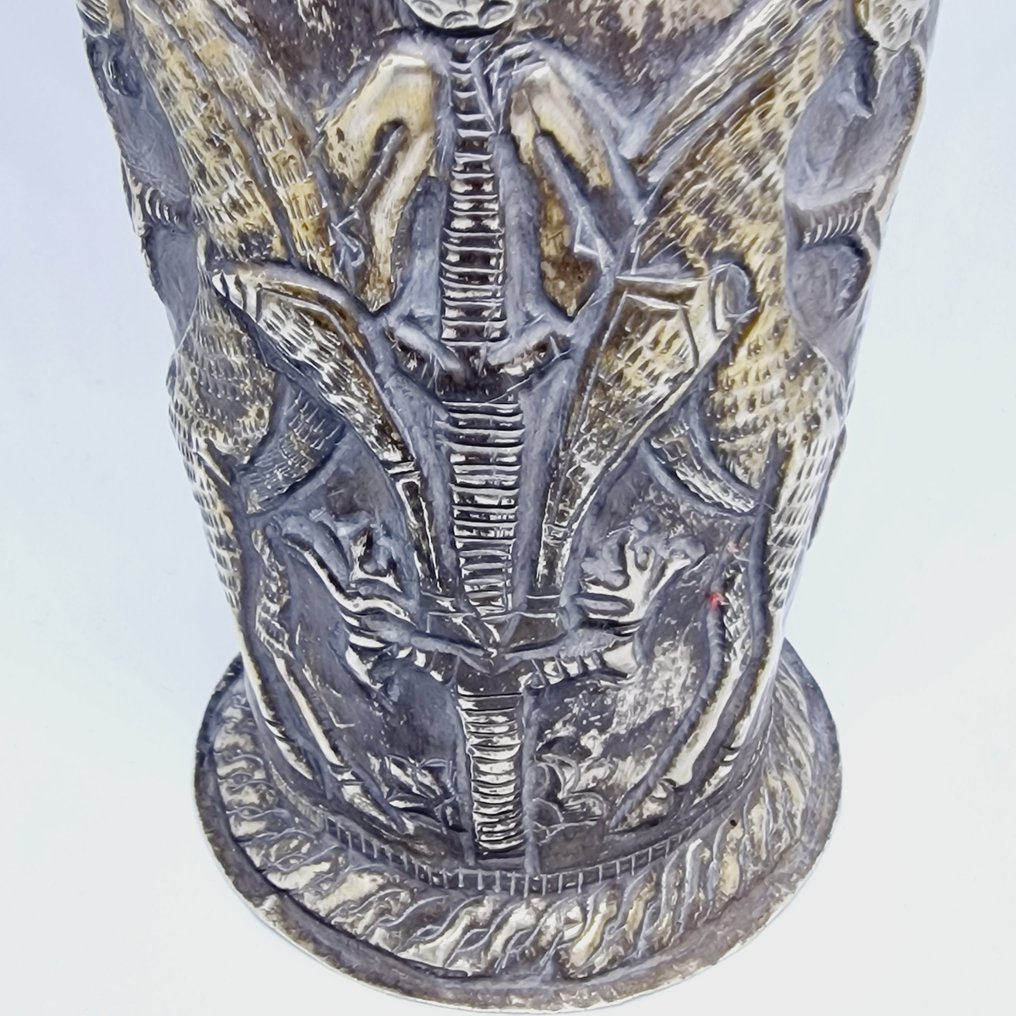
A rare gilded silver ritual cup with two standing ibexes with palm tree and flowers decor in the centre from the ancient Persian, Sogdian , Silk Road culture.
1st Millennium AD.
In good condition. It has been cleaned by hand, but the nice antique patina is preserved. Original, ancient, hand silversmith work. Traces of use and age on its surface.
Purchased mid 90's in Paris by Dr. Zelnik on the local art market.
About the Sogdian Culture :
Sogdian culture refers to the ancient culture of the Sogdians, an Iranian people who inhabited the region of Sogdiana, located in present-day Uzbekistan, Tajikistan, and parts of Kazakhstan and Turkmenistan. The Sogdians were renowned traders, diplomats, and artisans along the ancient Silk Road, playing a significant role in the cultural and economic exchanges between East and West.
Their culture was diverse and multifaceted:
Trade and Commerce: Sogdians were known for their expertise in trade and commerce. They established extensive trade networks that connected China, Central Asia, the Middle East, and Europe. Their strategic location along the Silk Road contributed significantly to their wealth and influence.
Language and Writing: The Sogdians had their own language, which was an Eastern Iranian language closely related to Persian. They had a script, which was an adaptation of the Aramaic script. Sogdian merchants used their language as a lingua franca in their trade interactions.
Art and Craftsmanship: Sogdian artisans were skilled in various crafts, including pottery, metalwork, and textiles. Their artistic expressions often incorporated elements from various cultures they encountered along the trade routes, resulting in a unique blend of styles.
Religion and Beliefs: Initially following Zoroastrianism, the Sogdians later adopted Buddhism and Manichaeism. They were known for their religious tolerance and the syncretic nature of their beliefs, which incorporated elements from various faiths.
Urban Centers: Sogdian cities, like Samarkand and Bukhara, were thriving urban centers along the Silk Road. These cities were hubs of cultural exchange, commerce, and learning.
Architecture: Sogdian architecture often reflected influences from different cultures, displaying a mix of Persian, Greek, and Central Asian styles.
The Sogdians played a crucial role as intermediaries, facilitating the exchange of goods, ideas, and cultures between the East and West during ancient times.
see also the link : https://sogdians.si.edu/introduction/
Important information :
The seller guarantees that he is entitled to ship this lot. Due to the complicated Cultural Laws we will not be able to ship this item outside of the EU nor to the United States.
Provenance :
This item comes from the collection of Dr. István Zelnik, resulting from more than 50 years of collecting.
Former diplomat, Asian Art collector, Researcher.
Publications :
More than 20 essays on Southeast Asian politics and economy.
Co-author of 10 albums and books on Southeast Asian Art.
A rare gilded silver ritual cup with two standing ibexes with palm tree and flowers decor in the centre from the ancient Persian, Sogdian , Silk Road culture.
1st Millennium AD.
In good condition. It has been cleaned by hand, but the nice antique patina is preserved. Original, ancient, hand silversmith work. Traces of use and age on its surface.
Purchased mid 90's in Paris by Dr. Zelnik on the local art market.
About the Sogdian Culture :
Sogdian culture refers to the ancient culture of the Sogdians, an Iranian people who inhabited the region of Sogdiana, located in present-day Uzbekistan, Tajikistan, and parts of Kazakhstan and Turkmenistan. The Sogdians were renowned traders, diplomats, and artisans along the ancient Silk Road, playing a significant role in the cultural and economic exchanges between East and West.
Their culture was diverse and multifaceted:
Trade and Commerce: Sogdians were known for their expertise in trade and commerce. They established extensive trade networks that connected China, Central Asia, the Middle East, and Europe. Their strategic location along the Silk Road contributed significantly to their wealth and influence.
Language and Writing: The Sogdians had their own language, which was an Eastern Iranian language closely related to Persian. They had a script, which was an adaptation of the Aramaic script. Sogdian merchants used their language as a lingua franca in their trade interactions.
Art and Craftsmanship: Sogdian artisans were skilled in various crafts, including pottery, metalwork, and textiles. Their artistic expressions often incorporated elements from various cultures they encountered along the trade routes, resulting in a unique blend of styles.
Religion and Beliefs: Initially following Zoroastrianism, the Sogdians later adopted Buddhism and Manichaeism. They were known for their religious tolerance and the syncretic nature of their beliefs, which incorporated elements from various faiths.
Urban Centers: Sogdian cities, like Samarkand and Bukhara, were thriving urban centers along the Silk Road. These cities were hubs of cultural exchange, commerce, and learning.
Architecture: Sogdian architecture often reflected influences from different cultures, displaying a mix of Persian, Greek, and Central Asian styles.
The Sogdians played a crucial role as intermediaries, facilitating the exchange of goods, ideas, and cultures between the East and West during ancient times.
see also the link : https://sogdians.si.edu/introduction/
Important information :
The seller guarantees that he is entitled to ship this lot. Due to the complicated Cultural Laws we will not be able to ship this item outside of the EU nor to the United States.
Provenance :
This item comes from the collection of Dr. István Zelnik, resulting from more than 50 years of collecting.
Former diplomat, Asian Art collector, Researcher.
Publications :
More than 20 essays on Southeast Asian politics and economy.
Co-author of 10 albums and books on Southeast Asian Art.
- 485
- 4
- 6
Thank you for this nice bead!
Se översättningThank you for this nice bead!
Se översättningThank you for these very nice beads!
Se översättningThank you for these nice beads!
Se översättningThank you for this nice bead!
Se översättningThank you for this nice bead!
Se översättningThank you for these nice beads!
Se översättningThank you for these nice beads!
Se översättningThank you for this very nice deity bead!
Se översättningThank you for this nice beads!
Se översättningThank you for this nice bead!
Se översättningThank you for this wonderful Buddha!
Se översättningThank you for this wonderful Buddha!
Se översättningThank you for this very nice tiger!
Se översättningThank you for this very nice bead!
Se översättningThank you for this very nice fish!
Se översättningThank you for this very nice deity!
Se översättningThank you for this very nice bead!
Se översättningThank you for these very nice beads!
Se översättningThank you for this very nice necklace!
Se översättningThank you for this very nice necklace!
Se översättningThank you for this very nice necklace!
Se översättningThank you for this very nice necklace!
Se översättningThank you for this very nice ring!
Se översättningAnsvarsfriskrivning
Säljaren garanterar och kan bevisa att objektet införskaffats på lagligt sätt. Säljaren har informerats av Catawiki att de måste lämna den dokumentation som är obligatorisk enligt lagar och regler i det land de är bosatta. Säljaren garanterar och har rätt att sälja/exportera detta objekt. Säljaren tillhandahåller all information om härkomst som är känd om objektet till köparen. Säljaren säkerställer att alla nödvändiga tillstånd är/kommer att bli ordnade. Säljaren informerar köparen omedelbart om eventuella förseningar gällande att anskaffa sådana tillstånd.
Säljaren garanterar och kan bevisa att objektet införskaffats på lagligt sätt. Säljaren har informerats av Catawiki att de måste lämna den dokumentation som är obligatorisk enligt lagar och regler i det land de är bosatta. Säljaren garanterar och har rätt att sälja/exportera detta objekt. Säljaren tillhandahåller all information om härkomst som är känd om objektet till köparen. Säljaren säkerställer att alla nödvändiga tillstånd är/kommer att bli ordnade. Säljaren informerar köparen omedelbart om eventuella förseningar gällande att anskaffa sådana tillstånd.
